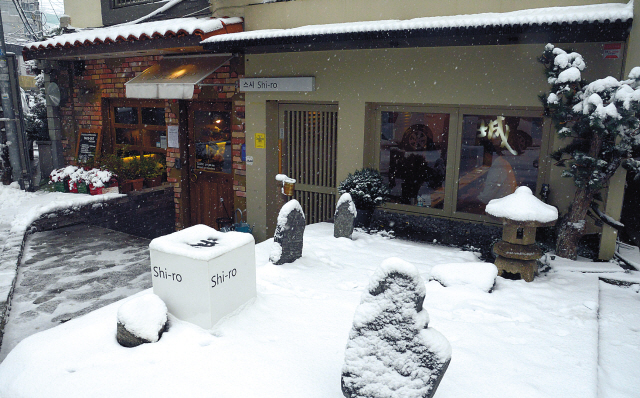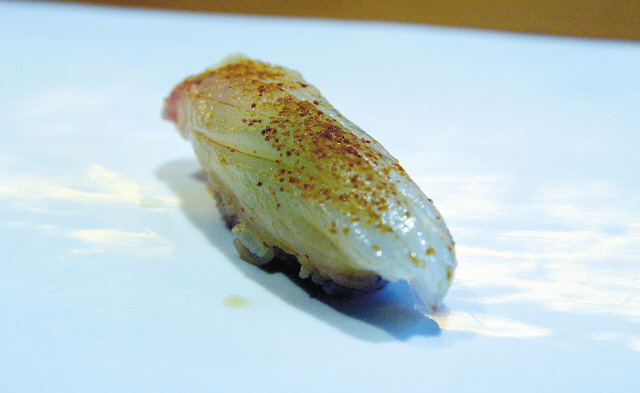 |
Located near Hongdae, Sushi Shi-ro offers diners a tranquil haven, which feels even more cozy when adorned with a thick blanket of snow.(Chung Hee-cho/The Korea Herald) |
Sushi Shi-ro marries affordability, quality and artistry in one fell swoop.
Situated near Hongdae, the pristine, minimalist sushi bar serves sets that range from 20,000 won to 40,000 won for lunch and 30,000 won to 60,000 won for dinner, and given what is doled out in return, dining at Shi-ro is a bargain.
At the counter, the patron is coddled and practically hand-fed carefully crafted sushi, one perfectly seasoned piece at a time, till the very last palate-tingling moment.
The experience, which can last a good hour or more, is, to say the least, blissful.
 |
Umami-tasting uni salt made from dried, grated sea urchin is sprinkled over hirame (halibut). |
Fashioning the menu from catch that is deemed best for that day adds a pleasant element of surprise to eating at Shi-ro, while sitting at the bar enhances the visual fun of it all.
Diners can watch head chef Kim Hyung-jun sprinkle umami-tasting uni salt (made from sea urchin that has been drained, dried and grated) over hirame (halibut) sushi, anticipating that soft, sweet meeting of raw fish and glossy grains of rice before taking a bite.
Kim also does not hesitate to showcase the establishment’s mastery of abalone, using it to initiate diners to the meal, serving up one half topped with moromi miso, the other with that fragrant, nutty delicacy ― abalone entrails, softened by a hint of cream.
Kim transforms mitra squid into a glass-like cut of chewy perfection, topping it with freshly grated yuja (brushed from the grater so that it lands in perfect, citrus-rich speckles of yellow over the sushi).
The fragrant bite is a mere prelude to Kim’s thorough exploration of sushi, which encompasses ruby cuts of bluefin and big-eye tuna and Osaka’s regional specialty, hako-zushi (mold-pressed sushi), which is made with chub mackerel to create a rectangular piece of hefty richness.
Kim also surprises the palate with sushi like the buttery engawa (halibut fin), slightly charred with a torch and sprinkled with dried shiso, for a smoky, aromatic oomph.
Kaisendon, essentially a sashimi rice bowl, is also served, complete with around seven ingredients ranging from delicacies like plump salmon roe, sea urchin and tuna to soy sauce-pickled amaebi (sweet raw shrimp).
Futomaki is crafted with sweet burdock root, tamago (egg) and other tasty tidbits lodged inside the large, nori-wrapped roll.
While sushi takes the lead, sets also come with egg custard, salad, miso soup, ochazuke (rice in hot broth) and dessert. Pricier omakase meals also include tempura and sashimi.
Of the decision not to go over-the-top and serve up high-end omakase sets in the 100,000-won range, head chef Kim explained why Shi-ro specializes in reasonably priced sushi, saying, “Well, the economy is not good.”
Kim described Shi-ro as a place looking to establish its own identity with wallet-friendly, good-quality sushi.
Now nearing its two year anniversary, Shi-ro seems to have succeeded in doing that and more.
Located within walking distance from Sangsu Station, the half-underground, cream-fronted spot also wins over with its ambiance.
The establishment looks and feels like a tranquil haven, even more so when blanketed with snow, and with only eight counter seats and six sit-down seats, it makes for a cozy, intimate dining experience.
Ironically enough, Shi-ro translates to “castle” in Japanese, which, one can only assume, is not meant to refer to the size of the restaurant itself, but to the fact that the place’s specialty is sushi.
Sushi Shi-ro
Sushi Shi-ro; 408-25, Seogyo-dong, Mapo-gu, Seoul; (02) 336-8353; open noon to 2:30 p.m. weekdays, 1 p.m. to 3:30 p.m. Saturdays and 6 p.m. to 10 p.m. Mondays through Saturdays, closed Sundays; sushi sets cost 20,000 won to 40,000 won for lunch, 30,000 won to 60,000 won for dinner; reservations necessary
By Jean Oh (
oh_jean@heraldcorp.com)








![[Exclusive] Hyundai Mobis eyes closer ties with BYD](http://res.heraldm.com/phpwas/restmb_idxmake.php?idx=644&simg=/content/image/2024/11/25/20241125050044_0.jpg)
![[Herald Review] 'Gangnam B-Side' combines social realism with masterful suspense, performance](http://res.heraldm.com/phpwas/restmb_idxmake.php?idx=644&simg=/content/image/2024/11/25/20241125050072_0.jpg)